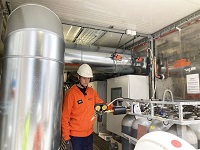VTT’s Carbonaide technology for manufacturing carbon negative concrete today wins innovation award of the year by the European Association of Research and Technology Organizations (EARTO).
Reports show that oncrete is one of the biggest single emitters of carbon dioxide. A new solution for manufacturing carbon negative concrete, developed within VTT’s Carbonaide project, aims to create a global environmental impact. EARTO, the organisation of the European Research and Technology Organisations, awarded VTT and this technology first prize in the category of Impact Expected. The award was given on October 12th, 2022, in Brussels.
Carbonaide solution is based on an effective carbonation method, which allows binding carbon dioxide into concrete blocks using an automated system at atmospheric pressure. ”The method is compatible with the current manufacturing processes of concrete. It can be used for manufacturing all precasted concrete elements and products,” states Tapio Vehmas, leader of the Carbonaide team and Senior Scientist at VTT.
When industrial side streams are used in the process, instead of normal cement, the result is concrete with a negative carbon footprint. Among the possible side streams, steel industry slags, green liquor dregs and bio-ash have been combined successfully in laboratory scale. Concrete manufactured with this method had a negative calculated carbon footprint of -60 kg per cubic metre of concrete. The carbon footprint of conventional concrete is approximately 250–300 kg per cubic metre. The difference was significative.
Solution is scalable and economically viable
Carbonaide is now ready for commercialisation and to be scaled for industrial production. The commercial spin-off is going forward with the support of the VTT LaunchPad business incubator, and Carbonaide has studied the commercialisation of the method with funding from Business Finland. The technology has been proven effective and economically viable for all parties.
”The details of the solution based on binding carbon dioxide have been specified within the work in the business incubator. We have shifted the focus of the technology further from the materials and developed the process from the commercial angle. Thanks to these changes, the method is now more scalable,” Vehmas says.
The process has been piloted with success, and the first objects using this technology have been carried out with Rakennusbetoni- ja Elementti Oy from Hollola, and with the construction company Skanska. Rakennusbetoni- ja Elementti Oy has used the technology to manufacture carbon negative yard paving, which has been installed at Skanska’s construction site this fall. The aim of the cooperation is to pilot carbon negative construction and to collect data on the behaviour of the materials. The active follow-up of the pilot and its results gives the basis for preparing industrial production.
Significant market potential
The global market of concrete products and elements is growing fast and amounts to approximately 370 billion US dollars annually. This offers great market potential for Carbonaide’s technology.
The solution also has a market in the carbon dioxide emission trade. Carbonaide’s business idea is to receive carbon dioxide from the emissions trading platforms, and to use it for the benefit of the technology. Thus, binding carbon dioxide opens another market for the company.
Carbonaide’s vision is to have 100 units of the production device installed in the global market by 2030. The goal is to bind approximately 500 megatons of carbon dioxide annually by 2050, which corresponds to 10–20% of the concrete market.

